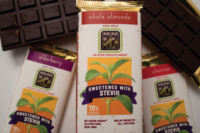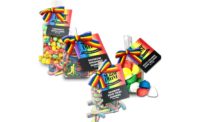
With diabetics being a main consumer of sugar-free products, it’s no wonder that a diabetic decided to start his own sugar-free company. President Gary Russell opened Fifty50 Foods in 1991 with the notion of giving half of the company’s profits to fund diabetes research. Since the company’s start, it has donated more than $11 million to diabetes research.
The company’s chocolate products include four varieties of chocolate bars: milk, dark, crunch and almond.
“Since [sugar free] is our only business, one of the things that we have always said is that we’re going to have the best tasting bar on the market,” Russell says. “Because it is a specialty item and as a diabetic, if you make a horrible bar, they’re not going to buy more than one.”
So how can manufacturers make a tasty sugar-free chocolate bar suitable for diabetics? “It’s a combination of things,” Russell explains.
“It’s a combination of a good quality chocolate plus we happen to prefer isomalt as a sweetener for our bars.”
Using isomalt allows Fifty50’s products to be low glycemic while keeping consumers’ blood sugar levels low, but longer lasting.
“We all like our sweets,” Russell says. And with the advances in sweeteners, all kinds of consumers can enjoy the benefits, and taste, of sugar-free chocolates – without the guilt.
Defining sugar-free
According to the U.S. Food and Drug Administration’s food labeling regulations, the terms “sugar free,” “no sugar” and “sugarless” are synonymous. These terms may be used to label foods that: contain less than 0.5g of sugars per serving and amount customarily consumed, do not contain sugar or any ingredient containing sugar unless followed by an asterisk referring to a statement below the nutritional information saying “adds a trivial amount of sugar,” and are labeled as “low calorie” or “reduced calorie” or includes the statement “not a reduced calorie food,” “not a low calorie food” or “not for weight control.”Additionally, the terms “no added sugar,” “without added sugar” and “no sugar added” are synonymous. They may be used on labels if: no sugars or ingredients containing sugars are added during processing or packaging; the product does not contain added sugars, such as jam, jelly or concentrated fruit juice; sugars have not been added to the amount already present in the product, unless the added sugars are not intended to increase the amount of sugar in a product and a functionally insignificant increase in sugars results; the food that the product resembles normally contains sugars; and the product is not labeled as “low calorie” or “calorie reduced,” unless it meets the criteria for those statements, and directs consumers to the nutrition panel for more information on sugar and calorie content.



